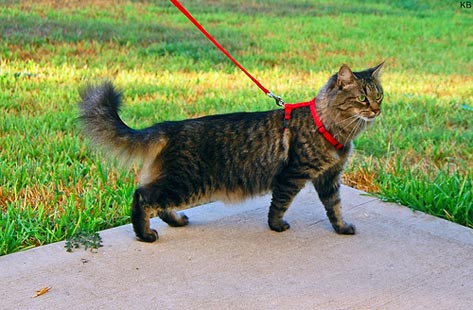

Ever seen a cat out walking on a leash? Most people who have seen one react with astonishment that a cat would be domesticated enough to willingly allow itself to be tethered to a leash and guided around by -- of all things! -- a human companion. But it can, and does happen. After all, why should dogs have all the fun? Everyone knows cats like the outdoors, too. Shouldn’t they get the opportunity to explore the great outdoors along with the rest of us? Shouldn’t they be allowed to maintain their youthful figures with some regular exercise? With proper supervision, patience, and consistency, you too can train your cat to walk on a leash.
Once a cat has reached the age when she has been fully vaccinated, it is safe for her to go outside. Remember that this is not so much to protect other animals from what she might be carrying, but to protect her from what they might be carrying. It is best to start as early as possible, before your cat has developed a fear of the outdoors or a fear of unusual noises. Older cats are often more reluctant to go outside on a leash -- or to be on a leash at all. It may take months to get her used to accepting a harness, and to being led, but with diligence and a wish to succeed, you can do it.
It will help a lot of your cat is already responsive to you. If you can call your cat and she consistently comes to you, you are already on a good track. If you do not have this type of relationship, you will need to start there. Using treats and lots of praise, call your cat to come to you. After some time, your cat will learn that coming when called will be rewarding.
Because cats are so agile, a simple collar around the neck is not enough to hold them -- they can easily pull out of the neck collar, even a well fitted one (and you do not want to make the collar so tight that there is a potential of cutting off air flow). Instead, use a good-quality harness that has been designed especially for cats.
A cat harness is typically made with an adjustable neck collar, which is attached to an adjustable body wrap. The harness should fit snug to the body, but not be so tight that air flow will be constricted. You should be able to fit two fingers under the harness at the neck and under the chest.
Depending on the harness, the leash should attach at the body strap or between the shoulders instead of at the neck. The clips holding the harness should snap securely -- they should not be the break away type that is commonly found in cat collars.
It may take some time before your cat gets used to wearing a harness, so start slowly. Set the new harness near your cat’s favorite area and allow her to see it, smell it, and even play with it at first. Offer her some treats and praise if he shows interest in the harness.
After a few days of this, hold your cat securely and give him a treat. As he’s eating the treat, drape the harness loosely over him and leave it for a few minutes. You may need to repeat this several times before actually adjusting it, just to get your cat used to the feel of the harness. Once she appears to be comfortable with having the harness on his body, put the harness on and tighten the straps so they fit snugly. Again, offer positive reinforcement and treats for allowing you to put the harness on her. Leave the harness on for a short period of time, a few minutes to start, with gradually more time.
Do not force the fitting. If your cat struggles too much, remove the harness and try again later. When she does accept the harness without struggle, give him lots of attention so that he associates wearing the harness with good times.
Once your cat is accepting the harness, let her wear it around the house, doing her normal activities. Gradually increase the amount of time your cat is left in the harness. You can even feeding her while she’s wearing the harness. Next, attach the leash to the harness, allowing her to drag the leash around. This is to get her used to the weight of the leash, but remember to keep an eye on her while she is dragging the leash. You don’t want her to get it tangled up on anything.
You can then graduate to walking around inside while holding the leash. Don’t pull on the leash and don’t try to force her to follow you at first, follow her lead instead. Every now and then stop and call her to you, giving her a treat and praise when she comes.
Finally, when she seems comfortable on the leash indoors, it is time to go outdoors. Begin with a short trip outside, maybe just as far as outside the door where your cat can sniff around and start getting used to the sounds and scents. After doing this a few times, you might take a short stroll around the block. Before you go any farther than the immediate area, get to know your neighborhood to make sure that your neighbors do not allow their dogs to roam freely -- or so that you know which areas to avoid because of roaming dogs. Choose the quietest and safest areas for your cat to walk in, so that the experience is pleasurable for both of you.
Although your cat’s usual collar does not need to be removed, it is not part of the harness system. However, you should leave the collar on, with its ID in place, just in case your cat gets loose while you are out.
For the first few walks, as your cat is getting used to being outside, you might want to take along a soft (or hard) carrier, just in case your cat has a panic attack, or in case you unexpectedly come up against a free roaming dog. A panicked or threatened cat is not going to want to be held in arms until it gets home.
This will work best if your cat has been spayed or neutered. An unneutered male cat may be more likely to try to escape the harness or get out of control while outside, and an unspayed female cat may be attacked by feral male cats.
Setting a regular time to walk each day will give your cat something to look forward to. Try to stay consistent.
Unlike dogs, cats cannot be tethered to a pole while you step into a shop, even for just a few minutes. Your cat might panic and get itself tangled in the leash, or it may be attacked by a dog and not be able to escape.
Image: Krikit / via Flickr
 Catittude: Why is My Cat so Mean?
By Helen Anne Travis
Has Kitty b
Catittude: Why is My Cat so Mean?
By Helen Anne Travis
Has Kitty b
 Keeping Odor Away With a Clean Litter Box
If you can count you
Keeping Odor Away With a Clean Litter Box
If you can count you
 Cat Scratching - How To Stop Your Cat Scratching The Furniture
Cat Scratching - How To Stop Your Cat Scratching The Furnitu
Cat Scratching - How To Stop Your Cat Scratching The Furniture
Cat Scratching - How To Stop Your Cat Scratching The Furnitu
 Kidney Failure in Cats
There are a variety of causes to kid
Kidney Failure in Cats
There are a variety of causes to kid
 How Do Cats Show Love? Let Us Count Six Ways
By Cheryl Lock
They’re known for
How Do Cats Show Love? Let Us Count Six Ways
By Cheryl Lock
They’re known for
Copyright © 2005-2016 Pet Information All Rights Reserved
Contact us: www162date@outlook.com